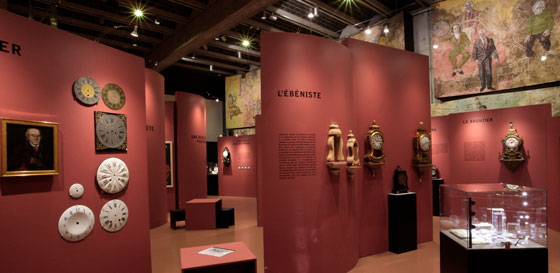
Two exhibitions on the same topic: the Neuchâtel clock. Two exhibitions which look at the subject from two different angles and give the public an opportunity to discover or rediscover the history of this mythical object which first made its appearance in the 18th century.
What do Friedrich II, King of Prussia, Ferdinand VI, King of Spain, Le Corbusier, Princess Grace of Monaco, US President Ronald Reagan, the Secretary General of the Communist party of the USSR, Mikhaïl Gorbatchev, the alpine skier Bernhard Russi and Federal Councillors Paul Chaudet, Pierre Aubert, and Pascal Couchepin have in common? They all have been or still are proud owners of a Neuchâtel clock!
In 2017, in other words precisely one century after the publication by Alfred Chapuis of his history of Neuchâtel clockmaking, at a time when manufacturers, the media and watch connoisseurs have their sights set on connected watches and their potential economic, social and cultural consequences, the clock may well seem to be a remote subject. Its history, which has seen so many successes and difficulties from the 18th century to the present day, remains little known. The Horological Museum of Le Locle - Château des Monts and the International Museum of Watchmaking (MIH) are taking a fresh look at the history and destiny of the «Neuchâtel» clock in a dual multilingual exhibition of international interest.
The exhibition entitled «La neuchâteloise», open with simultaneous and complementary displays in Le Locle and La Chaux-de-Fonds until 8 October 2017, testifies to cooperation between the two watch industry museums in the Canton of Neuchâtel which bring together the most important collection of its kind. It pays tribute to a heritage that is dear to them by placing this special clock in its original context while at the same time throwing new light on its characteristics.
Château des Monts
The Horological Museum of Le Locle looks at the technique of movements down the ages. It enables the typically regional art of Neuchâtel clockmaking to be understood. The exhibition highlights mechanical developments of the Neuchâtel clock since the first half of the 18th century until the present day and explains how its complications have evolved. Visitors will have the pleasure of discovering the characteristics and typical features of the movements exhibited outside their cases and in a sense «laid bare» for better scrutiny and appreciation. Through a history marked by the foremost names in Neuchâtel clockmaking, the exhibition shows how the mechanisms have evolved not just in technical terms but also from the aesthetic angle. The changes made in the course of time to the quadratures and striking-mechanisms reflect the desire of their makers to effect improvements and the ingenious techniques adopted by them. The public (re)discovers an exceptional production, especially from the mechanical point of view, which testifies to the intense activity of the Neuchâtel clockmakers, some more famous than others, over more than three centuries. The Neuchâtel clockmakers draw their inspiration from a long tradition, adapting and constantly innovating to take on board the progress of the competition so as to best reflect the taste of the time and win the approval of connoisseurs. The same productive logic also typifies more recent industrial objects. Brimming over with history and technical refinement, this rich body of works pays tribute to the expertise and skills of the finest clockmakers of their day.
International Museum of Watchmaking
The International Museum of Watchmaking proposes a thematic visit divided into three parts in its big exhibition room. After an introduction dedicated to a commemoration of the work of Alfred Chapuis, the first section of the exhibition looks at the artisans who lay at the origin of the Neuchâtel clocks. Alongside the watchmakers themselves, many other trades, some of them little known, are essential to the production of a clock: makers of hands, springs, dials, bronzes, cabinetmakers and cabinet painters. These trades are introduced through an iconography and component parts to demonstrate how they are made in all their rich diversity. The second section traces the development of the Neuchâtel clock and its growing success in the 18th century before the setbacks and renaissance of the 19th and 20th. A panorama which reflects the evolution of styles and fashions is painted with a didactic message. The commercial successes are presented through a number of iconic names who added an international dimension to Neuchâtel production. The way in which know-how has been handed down in the workshops and then through the schools is also examined. The last chapter considers the image of the Neuchâtel clock. The 20th century iconography refers to a clock that takes pride of place in a good many Neuchâtel homes. Endowed with a strong symbolic force, even though its economic importance to the canton falls far short of what it might have represented two centuries ago.
Publication
The issues round which the exhibitions are structured are the subject of articles specially published for the occasion by Editions Alphil. The answers given in this publication set out to be selective rather than exhaustive. The 230 page volume brings together contributions by some fifteen authors drawn from different horizons, historians and technicians of the watch industry. Its preface is signed by Alain Berset, a Federal Councillor. It sets out to present a synthesis of the Neuchâtel clock while also reflecting an approach to the history of that object as it is understood today.
Events
A whole series of events are being organised in the wings of the exhibitions. To invite the public to discover the many facets of this subject, the two partner museums put on conducted tours, activities during Neuchâtel Museums Night, International Museums Day and the Heritage Days. A closing talk will discuss the future of the Neuchâtel clock industry.
On both sites, activities specially designed for a young audience are open to families. Further information at: www.mih.ch and www.mhl-monts.ch.
May 24, 2017


 News
News